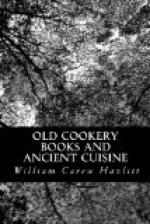Dr. Kitchener augmented this department of our literary stores in 1821 with his “Cook’s Oracle,” which was very successful, and passed through a series of editions.
In the preface to that of 1831, the editor describes the book as greatly enlarged and improved, and claims the “rapid and steady sale which has invariably attended each following edition” as a proof of the excellence of the work. I merely mention this, because in Kitchener’s own preface to the seventh issue, l2mo, 1823, he says: “This last time I have found little to add, and little to alter.” Such is human fallibility!
The “Cook’s Oracle” was heralded by an introduction which very few men could have written, and which represents the Doctor’s method of letting us know that, if we fancy him an impostor, we are much mistaken. “The following Recipes,” says he, “are not a mere marrowless collection of shreds and patches, of cuttings and pastings—but a bona-fide register of practical facts—accumulated by a perseverance, not to be subdued or evaporated by the igniferous Terrors of a Roasting Fire in the Dog-days:—in defiance of the odoriferous and calefaceous repellents of Roasting, Boiling,—Frying, and Broiling;—moreover, the author has submitted to a labour no preceding Cookery-Book-maker, perhaps, ever attempted to encounter,—having eaten each Receipt before he set it down in his Book.”
What could critics say, after this? One or two large editions must have been exhausted before they recovered their breath, and could discover how the learned Kitchener set down the receipts which he had previously devoured. But the language of the Preface helps to console us for the loss of Johnson’s threatened undertaking in this direction.
Dr. Kitchener proceeded on different lines from an artist who closely followed him in the order of publication; and the two did not probably clash in the slightest degree. The cooking world was large enough to hold Kitchener and the ci-devant chef to the most Christian King Louis XVI. and the Right Honourable the Earl of Sefton, Louis Eustache Ude. Ude was steward to the United Service Club, when he printed his “French Cook” in 1822. A very satisfactory and amusing account of this volume occurs in the “London Magazine” for January 1825. But whatever may be thought of Ude nowadays, he not only exerted considerable influence on the higher cookery of his day, but may almost be said to have been the founder of the modern French school in England.
Ude became chef at Crockford’s Club, which was built in 1827, the year in which his former employer, the Duke of York, died. There is a story that, on hearing of the Duke’s illness, Ude exclaimed, “Ah, mon pauvre Duc, how much you shall miss me where you are gone!”
About 1827, Mrs. Johnstone brought out her well-known contribution to this section of literature under the title of “The Cook and Housewife’s Manual,” veiling her authorship under the pseudonym of Mistress Margaret Dods, the landlady in Scott’s tale of “St. Ronan’s Well,” which appeared three years before (8vo, 1824).




